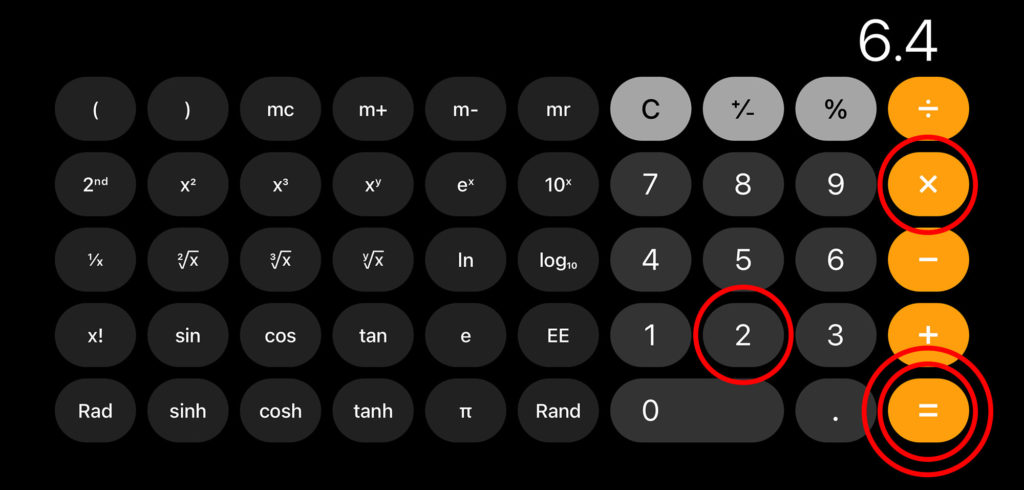If you fold a piece of paper in half 100 times (bonus: and then 103 times), how thick does it become?
Here’s the 100 paper folds problem (and the solution) explained so that anyone can understand it – with no weird or complicated maths, with no special mathematic notation, and with all workings shown (note: we’ll also go on to show how 103 folds is bigger than the size of the known universe as well – if you can believe that!).
Here’s all the Math – made REALLY easy to understand:
Let’s assume our piece of paper is 0.1mm thick (which actually corresponds almost exactly to the actual real-life thickness of the kind of standard piece of paper you’d very likely buy in any regular stationary shop or use in a home printer, i.e. paper with a standard paper-weight of 80g/m2).
Folding it in half once then, gives us a new thickness of 0.2mm.
Folding it a second time gives us 0.4mm.
The third fold: 0.8mm
The fourth fold: 1.6mm
The fifth fold: 3.2mm
The sixth fold: 6.4mm
Note: to follow along open your phone calculator, turn it on its side (landscape view) to allow more digits to be displayed and type: 0.1, then hit the × symbol and then type 2, then hit the = symbol, to give the answer 0.2, THEN hit the = symbol again, which should give you the answer 0.4, THEN just keep hitting the = symbol again and again and again to give 0.8, 1.6, 3.2, 6.4, etc, etc, etc, and so on (counting how many times you hit the = symbol as you go).

The 7th fold: 12.8mm
The 9th fold: 51.2mm
The 10th fold: 102.4mm
The 11th fold: 204.8mm
The 12th fold: 409.6mm
The 13th fold: 819.2mm
The 14th fold: 1,638.4mm
Note: there are 1,000 millimeters in a meter, so this is now just over 1.6meters thick. Still not much. It’s about to start getting significantly thicker and thicker though…
The 15th fold: 3,276.8mm
The 16th fold: 6,553.6mm
The 17th fold: 13,107.2mm
The 18th fold: 26,214.4mm
The 19th fold: 52,428.8mm
The 20th fold: 104,857.6mm
The 21st fold: 209,715.2mm
The 22nd fold: 419,430.4mm
The 23rd fold: 838,860.8mm
The 24th fold: 1,677,721.6mm
Note: there are 1,000,000 millimeters in one kilometer, so in just 24 folds we’re already over 1.6km (approximately one mile) in thickness!
The 25th fold: 3,355,443.2mm
The 26th fold: 6,710,886.4mm
Note: The height of Mt Everest is approximately 8,849,000mm (8,949 meters)
The 27th fold: 13,421,772.8mm
The 28th fold: 26,843,545.6mm
The 29th fold: 53,687,091.2mm
The 30th fold: 107,374,182.4mm
The 31st fold: 214,748,364.8mm
The 32nd fold: 429,496,729.6mm
The 33th fold: 858,993,459.2mm
The 34th fold: 1,717,986,918.4mm
The 35th fold: 3,435,973,836.8mm
The 36th fold: 6,871,947,673.6mm
The 37th fold: 13,743,895,347.2mm
The 38th fold: 27,487,790,694.4mm
The 39th fold: 54,975,581,388.8mm
The 40th fold: 109,951,162,777.6mm
The 41st fold: 219,902,325,555.2mm
Note: The distance from the earth to the moon is approximately 384,400,000,000mm (384 thousand km)
The 42nd fold: 439,804,651,110.4mm
The 43rd fold: 879,609,302,220.8mm
The 44th fold: 1,759,218,604,441.6mm
The 45th fold: 3,518,437,208,883.2mm
The 46th fold: 7,036,874,417,766.4mm
The 47th fold: 14,073,748,835,532.8mm
The 48th fold: 28,147,497,671,065.6mm
The 49th fold: 56,294,995,342,131.2mm
The 50th fold: 112,589,990,684,262mm
Note: The distance from the earth to the sun is approximately 147,130,000,000,000mm (147.13 million km)
The 51st fold: 225,179,981,368,525mm
The 52nd fold: 450,359,962,737,050mm
The 53rd fold: 900,719,925,474,099mm
The 54th fold: 1,801,439,850,948,200mm
The 55th fold: 3,602,879,701,896,400mm
Note: The distance from the earth to Pluto is approximately 5,322,900,000,000,000mm (5.3229 million km)
The 56th fold: 7,205,759,403,792,800mm
The 57th fold: 14,411,518,807,585,600mm
The 58th fold: 28,823,037,615,171,200mm
The 59th fold: 57,646,075,230,342,400mm
The 60th fold: 115,292,150,460,685,000mm
The 61st fold: 230,584,300,921,370,000mm
The 62nd fold: 461,168,601,842,740,000mm
The 63rd fold: 922,337,203,685,480,000mm
The 64th fold: 1,844,674,407,370,960,000mm
The 65th fold: 3,689,348,814,741,920,000mm
The 66th fold: 7,378,697,629,483,840,000mm
The 67th fold: 14,757,395,258,967,700,000mm
The 68th fold: 29,514,790,517,935,400,000mm
The 69th fold: 59,029,581,035,870,800,000mm
The 70th fold: 118,059,162,071,742,000,000mm
The 71st fold: 236,118,324,143,484,000,000mm
The 72nd fold: 472,236,648,286,968,000,000mm
The 73rd fold: 944,473,296,573,936,000,000mm
The 74th fold: 1,888,946,593,147,870,000,000mm
The 75th fold: 3,777,893,186,295,740,000,000mm
The 76th fold: 7,555,786,372,591,480,000,000mm
The 77th fold: 15,111,572,745,183,000,000,000mm
The 78th fold: 30,223,145,490,366,000,000,000mm
The 79th fold: 60,446,290,980,732,000,000,000mm
The 80th fold: 120,892,581,961,464,000,000,000mm
The 81st fold: 241,785,163,922,928,000,000,000mm
The 82nd fold: 483,570,327,845,856,000,000,000mm
The 83rd fold: 967,140,655,691,712,000,000,000mm
The 84th fold: 1,934,281,311,383,420,000,000,000mm
The 85th fold: 3,868,562,622,766,840,000,000,000mm
The 86th fold: 7,737,125,245,533,680,000,000,000mm
The 87th fold: 15,474,250,491,067,400,000,000,000mm
Note: The distance from the earth to the Andromeda Galaxy (the closest galaxy to our Milky Way Galaxy) is approximately 24,002,557,000,000,000,000,000,000mm (24,002,557 trillion km)
The 88th fold: 30,948,500,982,134,800,000,000,000mm
The 89th fold: 61,897,001,964,269,600,000,000,000mm
The 90th fold: 123,794,003,928,539,000,000,000,000mm
The 91st fold: 247,588,007,857,078,000,000,000,000mm
The 92nd fold: 495,176,015,714,156,000,000,000,000mm
The 93rd fold: 990,352,031,428,312,000,000,000,000mm
The 94th fold: 1,980,704,062,856,620,000,000,000,000mm
The 95th fold: 3,961,408,125,713,240,000,000,000,000mm
The 96th fold: 7,922,816,251,426,480,000,000,000,000mm
The 97th fold: 15,845,632,502,853,000,000,000,000,000mm
The 98th fold: 31,691,265,005,706,000,000,000,000,000mm
The 99th fold: 63,382,530,011,412,000,000,000,000,000mm
The 100th fold: 126,765,060,022,824,000,000,000,000,000mm
And HERE’S our answer (in millimeters)!
BUT HOW THICK IS THIS?! In order to convert millimeters into kilometers, we need to divide this by 1,000,000 (the number of mm in a km), which we can do really easily by just removing six zeros.
GIVING US…
The Answer:
ANSWER IN KM: 126,765,060,022,824,000,000,000km
Or said a different way:
≈ 126,765,060,022,824,000 million km !
Other ways to say this include:
≈126,765,060,022,824 billion km
≈126,765,060,022 trillion km
≈126,765,060 quadrillion km
≈126,765 quintillion km
≈126 sextillion km
Wow, that’s a heck of a LOT of kilometers!
Note: Exact Answers (Click to Expand)
Note: in order to keep things manageable, we’ve had to do some very slight rounding in our above calculations. The true answer, in millimeters, is: 126,765,060,022,822,940,149,670,320,537.6mm.
Or, hilariously: One hundred and twenty-six octillion, seven hundred and sixty-five septillion, sixty sextillion, twenty-two quintillion, eight hundred and twenty-two quadrillion, nine hundred and forty trillion, one hundred and forty-nine billion, six hundred and seventy million, three hundred and twenty thousand, five hundred and thirty-seven point six millimeters.
(Note: for the true-sticklers out there: I’m using the approximately equals sign (≈) above to give the final answers here because there has actually been some very slight rounding of the numbers along the way – to keep things manageable. See the above ‘Exact Answers’ box for the exact answer)
Let’s try to get more of a handle on this by comparing our final answer to some other distances.
The distance from the earth to the sun is 147.13 million km
(not even close)
This means our paper at 100 folds is approximately 861 trillion times the distance from the earth to the sun!!!
Let’s go for a larger distance: the distance from Earth to the Andromeda Galaxy (the closest galaxy from our Milky Way Galaxy) is approximately 2.537 million light years (or in other words 2,537,000 light years).
But how far is a light year? How many kilometers are there in a light year? The answer is that there are approximately 9,461,000 million km (or in other words approximately 9,461,000,000,000 km) in a light year.
Meaning Andromeda is approximately 2,537,000 × 9,461,000,000,000 = 24,002,557,000,000 million km away.
Meaning the thickness of our paper folded 100 times is still 5,281 times larger than even this incredible distance!!!
Bonus (up to 103 folds):
And in fact, just three more folds gets us to a paper thickness that’s THICKER THAN THE WIDTH OF THE ENTIRE KNOWN UNIVERSE!
The 101st fold: 253,530,120,045,648,000,000,000,000,000mm
The 102nd fold: 507,060,240,091,296,000,000,000,000,000mm
The 103rd fold: 1,014,120,480,182,590,000,000,000,000,000mm
Which stated in kilometers (by dividing by 1,000,000) equals approximately 1,014,120,480,182,590,000,000,000km
≈ approximately 1,014,120,480,182 trillion km !
Other ways to say this include:
≈1,014,120,480 quadrillion km
≈1,014,120 quintillion km
≈1,014 sextillion km
≈1 septillion km
Note: the width of the entire known universe is approximately 93.016 billion light years, which is, in km: approximately 93,016,000,000 × 9,461,000,000,000 = 880,024,376,000,000,000,000,000km
Which is larger? Well, it’s not easy to compare these two numbers, but our paper at the 103rd fold is larger!
Our paper folded 103 times has a thickness of approximately 1,014,120,480,182 trillion km, and the known universe is approximately 880,024,376,000 trillion km.
Meaning our paper at 103 folds is approximately 1,014,120,480,182 – 880,024,376,000 = 134,096,104,182 trillion km thicker than the known universe is wide!
ABSOLUTELY AMAZING!!!
Additional Notes:
The universe vs paper folded 103 times in mathematical notation (Click to Expand)
Our paper at 103 folds is approximately 1.01×10^24 km thick and the known universe is approximately 8.80×10^23 km wide.
The 100 paper folds problem (bonus 103 folds) in mathematical notation (Click to Expand)
Note also that you can of course calculate the 100 folds problem with simply 0.1×2^100 (for an exact answer) and the 103 folds problem with 0.1×2^103, but that’s hardly as much fun!
–The End–
Discover more from Brin Wilson...
Subscribe to get the latest posts sent to your email.




1 Comment
If You Fold A Paper 44 Times It Will Be Long As Saturn